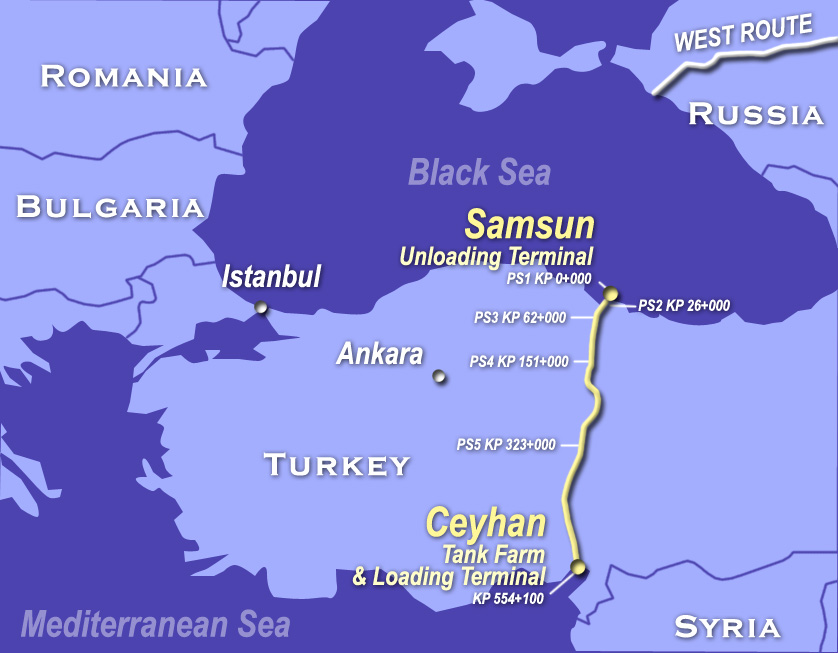
Russia Shows Interest in Samsun-Ceyhan Oil Pipeline Proposal
Publication: Eurasia Daily Monitor Volume: 6 Issue: 157
By:

Russian Prime Minister Vladimir Putin and his Turkish counterpart Recep Tayyip Erdogan signed a protocol on cooperation in the oil sector during Putin’s recent visit to Ankara (EDM, August 10, 11, 12). This protocol -one of several ambitious declarations of intent during Putin’s visit- focuses on building an oil pipeline across Turkey’s Anatolia peninsula, running north-south from Samsun on the Black Sea to Ceyhan on the Mediterranean. The project’s main selling point (long before Putin’s visit) is that the pipeline would bypass the dangerously congested Bosporus Strait.
Under this protocol, the Russian and Turkish governments are to create a joint working group to identify oil supply sources for the proposed pipeline and determine the transportation parameters. According to Putin, a Samsun-Ceyhan pipeline could become "fully attainable" if oil deliveries from Kazakhstan to Russia’s Black Sea coast are expanded as planned (Interfax, Anatolia news agency, August 6, 7).
The concept boldly presumes that Western companies in Kazakhstan would remain dependent on Russian transportation of their oil to the Black Sea for decades to come. Those companies’ production would have to be delivered from Kazakhstani oilfields via Russia to Novorossiysk on the Black Sea, with part of it then shipped by tankers to Samsun. This would provide the main throughput for the Samsun-Ceyhan pipeline, if the line is ever to be built.
The proposal dates back to 2005, when Italy’s state-controlled energy conglomerate ENI and the Turkish privately-owned Calik Energy established a 50/50 joint venture (Trans-Anatolian Pipeline Company, TAPCO) to build and operate a 555 kilometer Samsun-Ceyhan pipeline. The basic idea is to transport Kazakhstani and some Russian oil to the super-tanker port of Ceyhan, which Turkey aims to develop into a global energy hub. The Samsun-Ceyhan pipeline’s proposed capacity is 1 million barrels per day (bpd), or 50 million tons annually on completion of the first stage, growing to 1.5 bpd (75 million tons annually) in the second stage. These impressive targets are identical with the Baku-Tbilisi-Ceyhan pipeline’s first-stage (operational) and second-stage (planned) capacities. Samsun-Ceyhan raises a potential challenge to Baku-Tbilisi-Ceyhan inasmuch as the latter’s expansion plan relies on large oil inputs from Kazakhstan.
Samsun-Ceyhan "first-stone-laying" ceremonies were held in April 2007 and again in April 2009, honored by the Italian and Turkish energy ministers on both occasions. Those events did not jump-start construction work, however. An investment decision has yet to be made, contingent on deliveries of Kazakhstani and Russian oil from Novorossiysk and other Black Sea ports to Samsun. If a sizeable throughput is guaranteed, smaller inputs could possibly be added. The Russo-British TNK-BP company has expressed tentative interest in shipping some of its export volumes from Odessa (terminal of the reverse-used Odessa-Brody pipeline) by tanker for the Samsun-Ceyhan pipeline. Inputs on this relatively small scale cannot be decisive, however, in the absence of a large flow from Novorossiysk to Samsun.
Russian lack of interest stymied the Samsun-Ceyhan project until now. Samsun-Ceyhan implicitly competes with the Russian-led Burgas (Bulgaria)-Alexandropoulos (Greece) pipeline project (see below). This project envisages a Bosporus-bypassing outlet from the Black Sea to the Mediterranean, for Russian-delivered oil originating mainly in Kazakhstan. Thus, Samsun-Ceyhan appears somewhat redundant in relation to the earlier-planned Burgas-Alexandroupolis.
Prior to Putin’s Ankara visit, Russia had ignored and even snubbed the Samsun-Ceyhan proposal. ENI and the Turkish government had from the outset solicited Gazprom to participate in Samsun-Ceyhan through the GazpromNeft subsidiary. However, Gazprom (along with the Russian government) committed to Burgas-Alexandroupolis, and Putin was personally promoting this pipeline project.
Moscow, however, is now showing some interest in Samsun-Ceyhan for the first time. Following Putin’s visit, Erdogan and the Turkish government spokesman Cemil Cicek (addressing a government session and the media, respectively) said that ENI would commit oil volumes, from its own and other companies’ Caspian production, for the Samsun-Ceyhan pipeline; and that Russia would join the construction work and commit oil volumes to the planned pipeline (Anatolia news agency, August 10, 11).
Three factors probably explain Moscow’s tentative interest in Samsun-Ceyhan. First (in chronological order), American and European companies in Kazakhstan are reluctant or unwilling to finance the Burgas-Alexandroupolis pipeline project. Second, the new Bulgarian government, which took over in July, has suspended its participation in Burgas-Alexandroupolis and other major Russian projects in Bulgaria, pending a detailed review of their terms. Finally, the Turkish government has asked Russia to consider participating in Samsun-Ceyhan, allowing Russia in return to use Turkey’s Black Sea exclusive economic zone for Gazprom’s South Stream pipeline project. This quid-pro-quo is not officially acknowledged by the Turkish government, but is widely noted by Turkish, Russian, and international observers. Putin’s senior adviser Yury Ushakov made it public and explicit during the Ankara visit (Interfax, August 6), although it appears like exchanging castles made of air.




